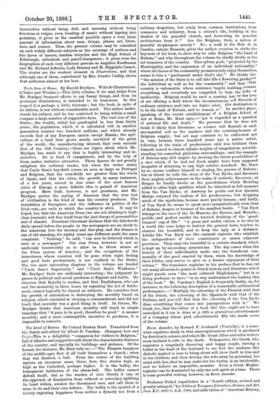The Land of Rubens. By Conrad Busken Huet. Translated from
the Dutch and edited by Albert D. Vandam. (Sampson Low and Co.)—This is a delightful "companion for visitors to Belgium," full of allusive and suggestive talk about the characteristic features of the country, and specially its buildings and pictures. Of the former, for instance, Mr. Huet tells us :—" The Flemish burghers of the middle ages first of all built themselves a church ; when that was finished, a hall. From the centre of the building uprises an enormous mass, three, four, five stories high, as high as the Cathedral, perhaps higher. It is the belfry, the transparent habitation of the alarm-bell. The belfry cannot defend itself; but as the warden of civic liberty it can, at the approach of domination from without or autocracy uplifting its head within, awaken the threatened ones, and call them to arms in its and their own defence. The belfry is the symbol of a society expecting happiness from neither a dynasty nor from a military despotism, but solely from common institutions, from commerce and industry, from a citizen's life, budding in the shadow of the peaceful church, and borrowing its peaceful architecture from it !" Are the Belgians, then, a nation of
peaceful shopkeepers merely ? No; a walk in the Bois de in Cambre, outside Brussels, gives the author occasion to strike the key-note of his book, to show why he calls Belgium "the Land of Rubens," and why throughout the volume he chiefly dwells on the art treasures of the country. This sylvan park, "projected by the
Municipality, and the expression of an individual nationality," where all classes of the community promiscuously enjoy themselves, seems to him a "parliament under God's sky." He thinks thy' "the mission of the State is to call into life a flowering garder'ar the individual as well as for the community," and that that country is unbearable where existence begets loathing Jamas° everything and everybody are compelled to bear the Yoke of mediocrity. Belgium would be such a country, but Jur her love of art offering a field where the inconsistencies pad discords of ordinary existence melt into one higher whole, .der destination is to be the land of Rubens, and to remain a.,." In another place, speaking of the recent establishment of a Belgian School of Art at Rome, Mr. Huet says,—" Art is regarded as a question of national life and death." We presume that he does not think it likely that literature or science will flourish in such uncongenial soil as the markets and the counting-houses of Belgium supply; but art may continue to be cultivated not in vain, because three hundred years ago a native artist, following in the train of predecessors only leas brilliant than himself, soared to almost infinite heights of imagination, notwith- standing his somewhat philistine surroundings ; and the example of Rubens may still inspire by showing the latent possibilities of a race which, if he had not lived, might have been supposed incapable of attaining to any high artistic standard. Mr. Huet by no means confines himself to singing the praises of Rubens ; but at Ghent he tells the story of the Van Eycks, and discusses their mighty achievements in the realm of (esthetic discovery ; at Bruges he fondly dwells on the gracefulness which Mending added to other high qualities which he inherited in full measure from the Van Eycks ; at Antwerp he points out how Quentin Metsys retained the realism of his predecessors, but dropping much of the mysticism, became more purely human ; and lastly, of Van Dyck he seems to speak more sympathetically even than of Rubens, despite or because of his manifest faults. "Van Dyck belongs to the race of the De Mussets, the Byrons, and Mozarts ; prolific and perfect amidst the hurried draining of the 'pearl- rimmed' cup of life." "A great and useful citizen is he who in a world like ours helps to fashion the general taste, teaches to observe the beautiful, and to keep the ugly at a distance. Artists like Van Dyck are like eminent captains wha establish the independence of their countrymen or annex adjacent provinces. They raise the beautiful to a certain standard, which is kept up by succeeding generations. The day comes when the history of their individuality melts into the beneficent com- monalty of the good enacted by them, when the knowledge of their foibles only serves to give us a keener enjoyment of their virtues." The translator explains in his preface that he has cut out many allusions to points in Dutch history and literature which might puzzle even "the most cultured Englishmen ;" but in so doing professes to have "in no way undermined the leading idea of the book." Mr. Vandam's English is frequently faulty, as, for instance, in the following description of a remarkable arithmetical performance :—" Multiply the colouring of the Flemish with that of the Dutch, the colouring of the Spaniards with that of the Italians, and you will find that the colouring of the Van Eycks dims everything that comes into juxtaposition with it." We think, too, that the editor of a book like this ought not to have embodied in it (as is done at p. 229) a gratuitous advertisement of a Company whose paid advertisement fills the inside cover of the volume.


































 Previous page
Previous page